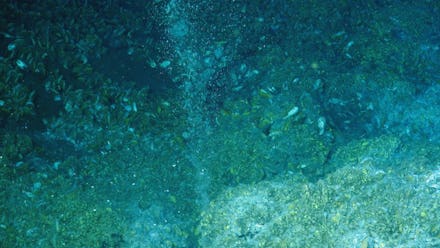Something's Leaking at the Bottom of the Ocean, And Scientists Are Extremely Concerned

Remember all that climate change business we've spent the past decade beating ourselves up about?
It's about to get a whole lot worse: Scientists have recently discovered deep deposits of a powerful warming gas leaking into the ocean from previously hidden vents just off North America's East Coast, kicking up underwater carbon dioxide levels. The source of the damaging gas, detailed in new research in the journal Nature Geoscience, is several hundred underwater inlets between the coasts of North Carolina and Massachusetts. Scientists think thousands of the seepage zones could lie hidden across the globe.
A perfect storm: Most of the vents are located about 1,600 feet down, the perfect spot for the ocean's temperature and water pressure to combine and create an oozing mix of ice and methane gas, a powerful substance with an impact on global warming that's 20 times more damaging than that of carbon dioxide. When it mixes with ice, the methane may form carbon dioxide bubbles that can be dispersed throughout the ocean.
At this time, the harmful gas hasn't entered the atmosphere; it remains trapped beneath the ocean's surface. For now.
But scientists are worried: Despite the methane remaining underwater, the sheer amount of trapped gas is certainly alarming. These undersea reserves could contain more than 10 times the amount of carbon that scientists had previously estimated was housed in our planet's atmosphere. Were it to escape, all of that hidden gas could turn scientists' climate models on their heads.
This would be especially scary considering we haven't had much luck reducing the warming we've already caused. Since we first started keeping track around 1900, the global temperature has increased nearly 1 degree Celsius; this may not seem like a lot, but it represents a sixth of all the temperature change that was necessary to bring Earth back from the ice age. Because we've continued to drive pollution at such a rapid rate, scientists estimate the Earth could warm twice as much, bringing us to somewhere between 2 and 6 degrees warmer by 2100.
As climate change gradually increases the temperature near the bottom the ocean, the steady stream of methane bubbles emanating from the ocean floor could turn into a series of powerful flares. If, however, that portion of the ocean were to cool, we could see the reverse of that trend — methane would begin seeping out more and more slowly until it might stop escaping.
Why it matters: The new research threatens to upend what we thought we knew about climate change, and it couldn't come at a better time. The United States remains one of the top five drivers of global warming, yet recent political debacles have stymied any real progress in reducing our contribution to climate change. With this finding hitting so close to home, perhaps we will take it as a renewed call to action.